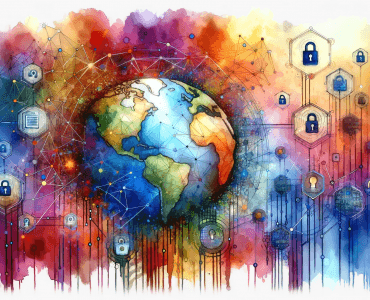In the ever-evolving landscape of technology, the emergence of Generative AI and sophisticated AI technologies has introduced a new frontier in the digital world, blending innovation with ethical dilemmas and cybersecurity concerns. A striking example of this complex interplay surfaced recently, involving a Ukrainian YouTuber, Olga Loiek, who discovered her digital clone selling Russian goods on the Chinese internet. This incident, a vivid illustration of AI digital clones cybercrime, illuminates the shadowy corners of digital replication, AI’s role in phishing, and cybercrime, revealing how technological advancements can serve both as tools for progress and instruments of deception.
Olga Loiek, a 20-year-old cognitive science student at the University of Pennsylvania and a burgeoning YouTuber, found herself entangled in an unexpected digital dilemma. Loiek’s online persona, cultivated through her YouTube channel focusing on mental health and life philosophies, was cloned without her consent. This AI-generated doppelganger, known variably as Natasha, Anna, or Grace, was not just a mere digital twin; it was a puppeteered entity designed to foster a fabricated affinity for China, speaking Mandarin fluently and promoting Russian goods to a Chinese audience.
AI digital clones and cybercrime
This phenomenon is not isolated. Around the Lunar New Year, a surge in videos featuring foreign-looking women, remarkably crafted through artificial intelligence, flooded Chinese social media platforms. These avatars, born from stolen and manipulated online images, present a disturbing reality where personal identities are co-opted and repurposed for commercial gain. The implications are profound, not only for the individuals whose identities are hijacked but also for the broader discourse on digital ethics and cybersecurity.

The technology at the heart of AI digital clones cybercrime controversy, Generative AI, has been a significant breakthrough, offering capabilities ranging from creating realistic images and videos to generating human-like text. However, its potential for misuse in phishing and cybercrime casts a shadow over its benefits. In the case of Loiek and others, Generative AI facilitated the creation of convincing digital clones, serving as a potent tool for deceptive marketing and potential misinformation campaigns.
This incident sheds light on the urgent need for robust cybersecurity measures and ethical guidelines governing the use of AI technologies. The ease with which digital identities can be replicated and repurposed underscores a growing threat landscape. Phishing scams, traditionally relying on deceptive emails and messages to extract personal information, can now harness the power of Generative AI to create more sophisticated and convincing lures. The digital replication of individuals for fraudulent purposes represents an evolution of cybercrime, where the lines between reality and fabrication become increasingly blurred.
Future impact
The broader implications of this development are multifaceted. On one hand, it highlights the remarkable advancements in AI and digital technology, offering a glimpse into a future where digital interactions could become indistinguishable from real-life engagements. On the other hand, it underscores a pressing need for international collaboration in establishing legal and ethical frameworks to govern the use of these technologies. As digital clones become more prevalent, questions about identity, privacy, and consent come to the forefront, demanding answers that balance innovation with individual rights and societal norms.
Furthermore, the incident speaks volumes about the geopolitical nuances interwoven with technology. The specific targeting of a Ukrainian identity to promote Russian goods in China via an AI-generated persona touches upon the intricate relationships between national identities, international relations, and digital commerce. It underscores how technology can be co-opted into broader narratives and tensions, making the digital realm an extension of geopolitical dynamics.
Now what?
The discovery of Olga Loiek’s AI clone on the Chinese internet is a cautionary tale of the double-edged sword that is Generative AI and digital technology, particularly highlighting the issue of AI digital clones cybercrime. While offering unparalleled opportunities for innovation and engagement, these technologies also present new challenges in cybersecurity, ethics, and international relations. The incident underscores the imperative for a concerted global effort to address these challenges, ensuring that the digital future is secure, ethical, and respectful of individual identities. As we navigate this uncharted territory, the balance between harnessing the potential of AI and safeguarding against its misuse will be pivotal in shaping the trajectory of our digital society.
“Don’t be afraid to give up the good to go for the great.” -John D. Rockefeller
I endeavor to highlight stories like on my website. This serves a dual purpose: firstly, to provide a valuable reference for my writing endeavors, and secondly, to share insightful narratives with the wider community.
If you like this story you should check out some of the other stories in the Small Business
To check the original story Click here







